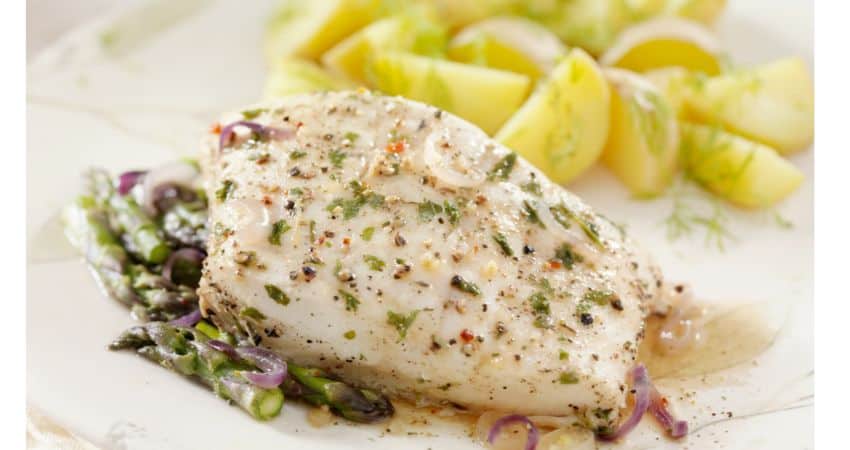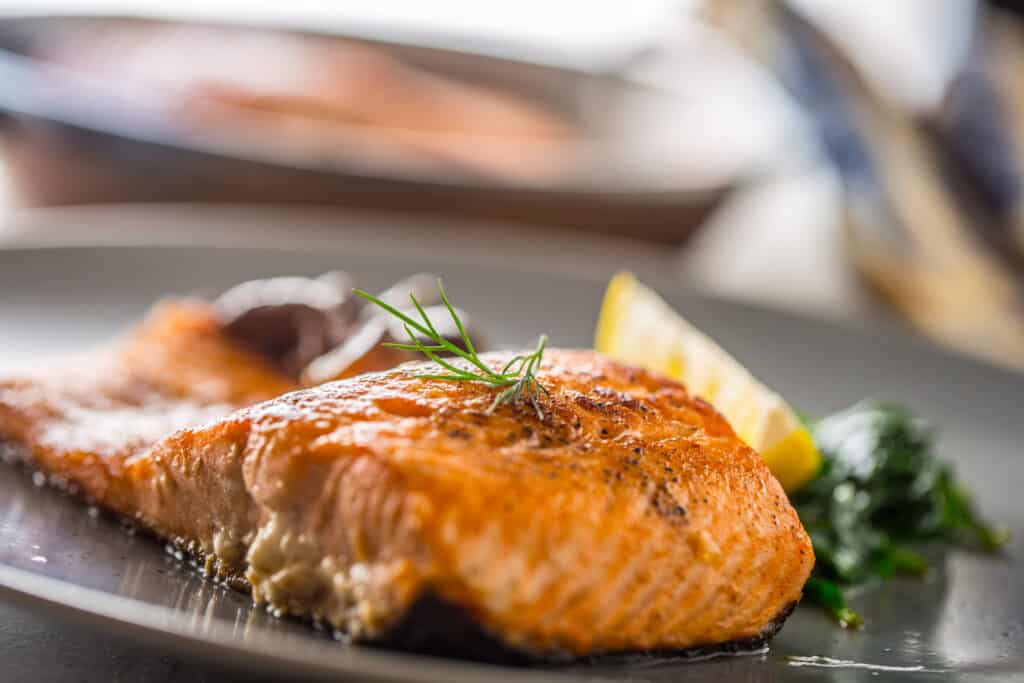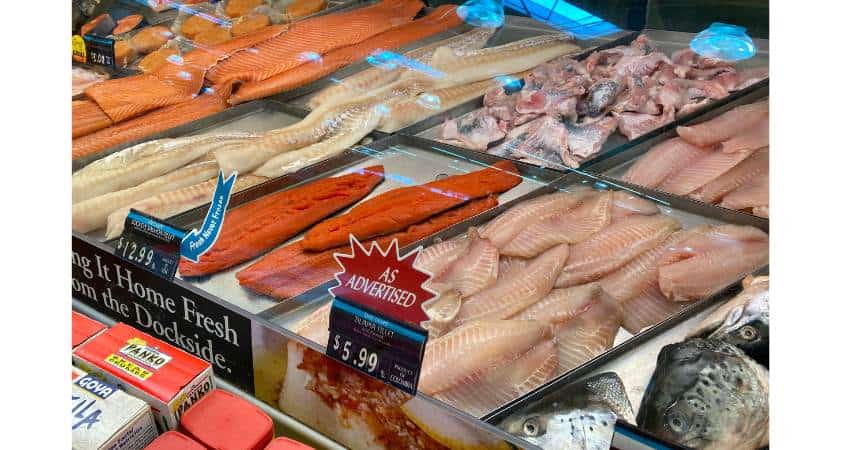Halibut vs Salmon: Which is Better? A Complete Comparison
If you have ever wondered whether salmon or halibut is different or better, you have come to the right article.
Aside from size, color, texture, and taste, the primary difference between halibut and salmon is the nutritional facts. There is a 56 percent caloric difference between the two fish species. Salmon contains more omega-3 fatty acids, vitamins and minerals.
If you are interested in learning which fish is best for your health, read on! This article will cover some differences and nutritional facts that will help you determine which one you may choose. In addition, the mercury levels of each one is examined.
Halibut vs Salmon: The Basics

As a Certified Health Coach many clients ask me about food comparisons including salmon and halibut. I purchase and consume salmon every week. Therefore, I have researched this topic in the past and present. Let’s examine them closely.
You can find halibut in the saltwater areas of Alaska, down to the saltwater areas in California. According to the National Oceanic and Atmospheric Administration, they primarily live in the Central Gulf of Alaska near Kodiak Island. Deep-sea fishing for halibut is a popular sport in Alaska1.
While one could hold a salmon in one hand, halibut can grow to be up to eight feet long and weigh up to 200 or even 400 pounds. Halibut is one of the largest saltwater flatfish out there2.
Salmon is renowned for being a part of many diets, whether vegetarian or keto. They are freshwater fish, but actually, they know the best of both worlds. They are typically born in freshwater rivers or streams.
Halibut vs Salmon: Nutritional Values
| Nutrient |
Salmon, raw (4 Ounces) |
Halibut, raw (4 Ounces) |
| Calories | 161 | 103 |
| Fat | 7.2 g | 1.5 g |
| Protein | 23 g | 21 g |
| Omega-3 | 1.95 g | 0.25 g |
| B-6 | 0.9 mg | 0.6 mg |
| B-12 | 3.6 mcg | 1.2 mcg |
| Vitamin A | 13.6 mcg | 22.6 mcg |
| Niacin | 8.9 mg | 7.3 mg |
| Folate | 28.3 mcg | 13.6 mcg |
| Potassium | 555 mg | 493 mg |
| Magnesium | 32 mg | 26 mg |
| Phosphorus | 226 mg | 267 mg |
| Calcium | 13.6 mg | 7.9 mg |
| Zinc | 0.7 mg | 0.4 mg |
| Selenium | 41.4 mcg | 51.7 mcg |
After examining the nutritional table above, it’s easy to see both fish contain many vitamins and minerals.
Salmon is healthier than halibut because it contains almost 8 times more heart healthy omega-3 fatty acids. Salmon also contains a higher number of vitamins and minerals and is lower in mercury.
Although salmon may have the edge, halibut is no slouch. It’s also a source of fatty acids and omega 3s, an excellent way to get your vitamins in.
Halibut Benefits

A good cut of halibut also contains folic acids, vitamin B6 and vitamin B123. These fatty acids are one of the best things you can do to ensure your heart stays healthy.
In addition to being a great source of healthy vitamins, halibut can also provide you with a healthy dose of magnesium. Adding magnesium to your diet could be instrumental in improving your sleep quality. More so, it will help keep your blood pressure levels balanced and stable.
Additionally, eating halibut will help you maintain cellular health, thanks to all the vitamin B12 it contains. The B vitamins and pyridoxine in halibut will also improve digestion and immunity while controlling cholesterol levels.
Salmon Benefits

Like halibut, salmon has plenty of health benefits and probably tops the list for one of the best fish to eat. First and foremost, salmon contains high amounts of heart-healthy, fatty omega 3s4. These fatty acids will help keep your cholesterol levels under control while strengthening your arteries.
These things can, in turn, help prevent you from suffering things like a stroke, heart attack, hypertension, and several other heart-related issues ((National Center for Biotechnology: Marine Omega-3 Supplementation and Cardiovascular Disease)).
Salmon is also very high in protein, but unlike many red types of meat, it does not contain potentially cancerous compounds. The increased protein levels will help improve your digestive system’s performance, as well as provide you with a fair amount of healthy cholesterol.
As mentioned before, salmon contains vitamins and minerals like iron, phosphorus, calcium, potassium and several others.
Believe it or not, the fatty omega 3s in salmon are very beneficial for your skin. Eating salmon could help you to achieve a healthy glow on your skin. Additionally, salmon provides metabolic nutrients that strengthen your hair and nails.
It contains dozens of antioxidants, astaxanthin among the most prominent ones. The antioxidants keep the number of free radicals in your body under control and prevent them from damaging your skin.
I compared the nutrition between these two popular salmons. Find out which one was more nutritious in my article, Atlantic vs Pacific Salmon: What’s The Difference?
Halibut vs Salmon: Taste and Texture
Whether fried or sauteed, halibut is a delicious meal. Fishermen and women who love to fish off the Gulf of Alaska predominantly choose to catch halibut. Halibut is a very lean fish and has a firm texture. The meat is sweet and will make a good meal for anyone anywhere.
Salmon has a very tender, buttery texture while halibut is, as mentioned before, firm and lean. Salmon is also flavorful and filling fish, so a smaller portion usually goes a long way.
My Taste Poll and Taste Test at Home
I wanted to get the opinion of real people like you and me. Therefore, I wanted to conduct my own research and contacted my clients, readers and members of food groups I belong to. I asked them which of the two fish they preferred.
- 52% said they preferred the taste of sockeye.
- 36% said they preferred the taste of halibut.
- 12% said they had no preference, or it depended on their mood.
I then set up a blind test taste at my home. I prepared both fish the same way using the same seasonings. Three out of five people, 60% chose the salmon. They said the flavor was better.
Halibut and Salmon Substitutions
Sometimes you won’t have the exact fish for a recipe, or the seafood section of the supermarket doesn’t have what you need. Therefore, substitution is a must.
Although halibut and salmon have different textures and tastes, they can substitute for each other. Halibut can be cooked the same as salmon like searing, poached or slow-roasted.
When substituting one fish for the other always stick to the following:
- Same size and weight.
- Stick with similar fillets, whole fillet or cross section.
- Stick with skinless or skin when the recipe calls for one.
- Texture is more important for certain cooking methods. Like using a firmer texture when grilling5.
Halibut and Salmon Mercury Levels
The FDA and EPA have issued advice regarding consuming fish and mercury levels6. They developed an easy to read chart about which fish has higher mercury levels than others. In addition, they list how many times each fish should be consumed each week based on their mercury levels.
Halibut has safe levels of mercury and is listed under the FDA’s good choices of fish to eat. The FDA recommends eating one serving of halibut a week.
Salmon is lower in mercury and listed under the FDA’s best choices for fish to eat. The FDA recommends salmon is safe to eat two to three servings a week.
The only potential issue with consuming excessive halibut is the amount of mercury in the meat (several varieties of fish contain mercury). Few people eat halibut enough to be at risk of a mercury “overdose.”
The risk of getting mercury poisoning is low. Pay attention to how frequently you eat halibut to avoid “overdosing.” The generally advised consumption amount for halibut is once a week for the best results. Just be aware of how much you eat.
Always check with a physician prior to eating new foods or changing your dietary habits.
The Cost of Halibut and Salmon

The cost of either halibut or salmon will differ depending on the location, fresh or frozen and whether it’s farm raised or wild caught.
Halibut is more expensive than salmon. The average cost for salmon is $12.49 per pound while the average cost for halibut is $25.99 per pound. The cost will vary depending on location, whether it is farm-raised or wild-caught, fresh or frozen.
I visited and checked my local Shoprite Supermarket and other markets for the current prices of each.
- Fresh, farm raised halibut
- $21.99 per pound.
- Fresh, wild caught halibut
- $29.99 per pound
- Fresh, farm raised Atlantic salmon
- $9.99 per pound
- Fresh, wild caught Coho salmon
- $14.99 per pound
If you have any questions to ask me about this article don’t hesitate to comment below or email us. You can find an email on our contact page.
Read Next – More Salmon vs Fish Articles!
Steelhead vs Salmon: Which Is Better?
Rainbow Trout vs Salmon: Is One Better?
Trout vs Salmon: Is One More Healthier Than The Other?
Shrimp vs. Salmon: A Complete Comparison
Char vs. Salmon – A Complete Comparison
- NOAA: Pacific Halibut [↩]
- University of Maine: Maine Seafood Guide – Halibut [↩]
- Nutrition Value: Fish, raw, Atlantic and Pacific, halibut [↩]
- Nutrition Value: Fish, raw, wild, Atlantic, salmon [↩]
- Sea Grant North Carolina: Fish Flavors and Substitutions [↩]
- FDA: Advice about Eating Fish [↩]
